ISSN ONLINE(2319-8753)PRINT(2347-6710)
ISSN ONLINE(2319-8753)PRINT(2347-6710)
Shridhar Kurse1, Narendra Viswanath2, K . S. Srinivasan3, Pradeep S4
|
| Related article at Pubmed, Scholar Google |
Visit for more related articles at International Journal of Innovative Research in Science, Engineering and Technology
Machinery prognosis is the forecast of the remaining operational life, future condition, or probability of reliable operation of the machine based on the acquired condition monitoring data. This approach to modern maintenance practice promises to reduce downtime, spares inventory, maintenance costs, and safety hazards. However, prognosis approaches are not accurate enough, which has become the bottleneck for achieving the full power of Condition-Based Maintenance (CBM). Artificial Neural Network (ANN) based methods have been considered to be a very promising category of methods for machine health condition prediction. In this paper, we train a neural network prediction model called Nonlinear Autoregressive Neural Network with eXogenous inputs (NARX) for a Multi-Step ahead prediction of deteriorating bearing signal. The NARX network is trained using a bearing dataset from FEMTO-ST Institute [1]. As a result the trained network shows satisfactory results for (short term) multi-step ahead prediction. However the long term prediction is challenging and needs further probe. MatLab software is used for network training. Both acceleration and temperature data are used for prognosis.
Keywords |
| Medium carbon steel, heat affected zone, grain refinement, mechanical properties |
INTRODUCTION |
| Effective maintenance of machine and equipment provide great economics contribution to an industrial plant. It has played more and more important role in the modern industry. An inadequate maintenance strategy may lead to unnecessarily high downtime or accidental breakdown of machine that lose a lot of money, and even human life. The best means of medium and long term assurance of factor such as continuity in production, preservation of investments and effective operation of the plant, can be provide by the application of a continuous and effective maintenance system and the prediction of probable defects beforehand and taking the necessary measures. |
| In maintenance approaches, the CBM is growing in popularity in industries. It is assessed as the most effective technology that can identify incipient faults before they become critical to enable more accurate planning of maintenance, while the others such as corrective and predetermined approach have shown to be costly in many applications due to, e.g., lost production, cost of keeping spare parts, quality deficiencies, etc. Fault diagnosis and prognosis, which can estimate and forecast the machine states, have significant roles in a CBM system. Finding an excellent model of fault diagnosis and prognosis is the key to enable CBM system to be more useful in practical applications. In order to evaluate the states of machine, the condition monitoring data must be acquired and processed by using appropriate signal processing techniques before being applied in diagnosis or prognosis model. Thus for the last decades CBM has been the subject of extensive research. Fault detection, diagnosis and prognosis are the three main stages of CBM. Detection comprises of determining that the damage has occurred to the bearing, while diagnosis is a determination of the location and type of fault, whereas prognosis involves estimation of the remaining life of the damaged bearing and investigation of failure modes [2]. |
| A significant objective of CBM is to predict the machine health or Remaining Useful Life (RUL) instead of its service time, which leads to anticipated usage of the machine, reduction in downtime and enhanced operational safety. |
2. DEFINITION OF PROGNOSIS |
| Prognosis [2] corresponds to the “estimation of the time to failure and the risk for one or more existing and future failure modes”. It’s the art or act of predicting future conditions on the basis of present signs and symptoms. It is a rapidly developing field and seeks to build on current diagnostic equipment capabilities for predicting the system state in advance. In machine condition prognostics, the current and past observations are used to predict the future health state of the machine and its RUL estimation. Accurate and reliable decision making using prognostics has a very important role in effective utilization and maintenance of machinery systems. Various temporal patterns including oil debris analysis, acoustic and vibration signals, and temperature may be used for the prediction of machine condition. Among these, vibration-based monitoring and prognostic approach is quite common in CBM of machines due to the ease of vibration measurement and analysis [2-3]. Most of the research related to CBM is mainly focused on fault diagnostic. Failure prognostic is a new research domain and there is a wide scope to develop methods, tools and applications for effective prognostic system. |
| Prognostic methods can be classified into three main categories as shown in the Fig. 1. |
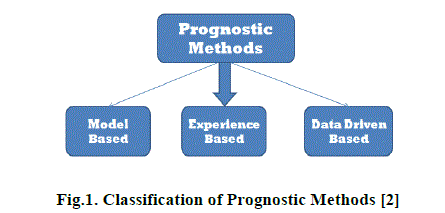 |
2.1 Model-Based Prognostic Method |
| Model-based prognostic [3] approaches are applicable to where the accurate mathematical models can be constructed based on the physical fundamentals of a system. These approaches use residuals as features, which are the outcomes of consistency checks between the sensed measurements of system and the outputs of a mathematical model. However, these techniques are merely applied for some specific components and each requires a different mathematical model. Changes in structural dynamics and operating conditions can affect the mathematical model as it is impossible to model all real-life conditions. Furthermore, a suitable model is difficult to establish to mimic the real life. |
2.2 Experience-Based Prognostic Method |
| Experience-based prognostic approaches require the component failure history data or operational usage profile data. They involve in collecting statistical information from a large number of component samples to indicate the survival duration of a component before a failure occurs and use these statistical parameters to predict the RUL of individual components. Generally, they are the least complex forms of prognostic techniques and their accuracy is not high because they base solely on the analysis of the past experience. |
2.3 Data-Driven Prognostic Method |
| Data-driven prognostic approaches are also known as data mining or machine learning techniques. They utilize and require large amount of historical failure data to build a prognostic model that learns the system behavior. In these methods an online data is captured with the help of sensors and converted into relevant information. It is then used to study the degradation phenomenon based on different models and tools like (neuronal networks, Bayesian networks, Markovian processes, etc.) or statistical methods, to learn the degradation model and to predict the future health state and the corresponding RUL of the system[2-4]. |
| Data-Driven Methods have advantage over both of the above methods i.e. model-based prognostic methods and experience-based prognostic methods as in one hand, in real industrial applications getting reliable data is easier than constructing physical or analytical behavior models and in the other hand, the generated behavioral models from real monitoring data lead to more precise prognostic results than those obtained from experience feedback data [4]. On the other hand, data driven prognosis model does not require assumption of physics parameter, thus it is easy to apply. ANN is most commonly found as a data driven technique in prognosis system. Normally, ANN consists of input layer, one or several hidden layers and output layer [5]. |
| In this paper we have used a data-driven prognosis approach that uses Multi-step ahead (MS) prediction methodology for forecasting the bearing operating condition. MS prediction plays a crucial role in industry by providing information on the RUL of machine ranging from system identification to ecology. [4] In this paper, a time-series prediction capability of ANN technique like Narxnet is utilized for machinery prognostics. |
3. TIME-SERIES PREDICTION |
| In [3] the prediction of a time series, x(t), the value at r time steps ahead, xt+r, is obtained in advance based on its values at previous time steps including the present one (xt-mr, xt-(m-1)r ,xt-(m-2)r,…..,xt-3r,xt-2r,xt-r,xt) is as follows: xt+r= (xt-mr , xt-(m-1)r, xt-(m-2)r,…………,xt-3r, xt-2r, xt-r, xt), m, r ≤ 0 |
3.1 REMAINING USEFUL LIFE (RUL) |
| RUL, also called remaining service life, residual life or remnant life, refers to the time left before observing a failure, given the current machine age and condition, and the past operation profile[9]. |
4. LITERATURE SURVEY |
| B. Samanta et al. [3]. In this paper, time-series prediction capabilities of artificial intelligence [AI] and soft computing [SC] techniques like adaptive neuro-fuzzy inference system (ANFIS) and support vector regression (SVR) are utilized for machinery prognostics of different machine components faults like gear wear; gear tooth chipping; gear tooth crack; gear pitting; shaft misalignment. As a result both ANFIS and SVR performed quite well for the test cases. The performance of SVR was found to be better than that of ANFIS. However, the training time of SVR was much higher than for ANFIS. |
| Data-driven approaches proposed by Van Tung Tran et al. [4] to predict the operating conditions of machine are based on classification and regression trees (CART) and adaptive neuro-fuzzy inference system (ANFIS). From the predicted results obtained from the CART and ANFIS models, shows that prediction model can track the change in machine conditions and has the potential for using as a tool to machine fault prognosis. |
| Abd Kadir Mahamada et al.[5] authors used the vibration signals of “bearing data” and proposes ANN in achieving more accurate RUL prediction of bearing failure, using root mean square (RMS) and kurtosis as input for ANN, whereas normalized life percentage as output. By doing that, the noise of a degradation signal from a target bearing can be minimized and the accuracy of prognosis system can be improved. The results from the proposed ANN gave good performance in predicting RUL of a bearing failure. |
| Zhigang Tian et al. [6] conducted the experiment using “gearbox test rig” for prediction of remaining useful life [RUL] by using extended recurrent neural network [ERNN] and fully connected recurrent neural network [FCRNN]. Here they compared both ERNN and FCRNN by various hidden neurons and as a result they concludes that the ERNN based approach for producing satisfactory health condition prediction results and also demonstrates ERNN as an effective neural network model for health condition prediction gives the best prediction results. |
| In ref. [7], Wilson et al. The authors have compared the two types of predictor recurrent neural networks (RNNs) and Neuro-fuzzy (NF) systems by using two typical time-series data sets. The performance of the developed prognostic system is evaluated by using three test cases including a worn gear, a chipped gear, and a cracked gear. From the test result of RNN and NF the author conclude that NF prognostic system is found to be a very reliable and robust machine health condition predictor. It can capture the system dynamic behavior quickly and accurately |
| In ref. [8], Nagi Gebraeel et al. Developed neural network based models for predicting bearing failure. Feed forward back propagation network is proposed. An experimental setup is developed to perform accelerated bearing tests where vibration information is collected from a number of bearings that are run until failure. This information is then used to train neural network models on predicting bearing operating times. Vibration data from a set of validation bearings are then applied to these network models. Resulting predictions are then used to estimate the bearing failure time. These predictions are then compared with the actual lives of the validation bearings and errors are computed to evaluate the effectiveness of each model. |
5. BEARING EXPERIMENTAL DATASET |
| The dataset is available from the FEMTO-ST [1] Institute which are being made publicly available. Experiments were carried out on a laboratory experimental platform that enables accelerated degradation of bearings under constant and/or variable operating conditions, while gathering online health monitoring data (rotating speed, load force, vibration). |
| The characterization of the bearing's degradation is based on two data types of sensors: vibration and temperature The vibration sensors consists of two miniature accelerometers positioned at 90 degree to each other; the first is placed on the vertical axis and the second is placed on the horizontal axis. The two accelerometers are placed radially on the external race of the bearing. The temperature sensor is an RTD (Resistance Temperature Detector) platinum PT100 (1/3 DIN class) probe, which is place inside a hole close to the external bearing's ring. The acceleration measures are sampled at 25.6 kHz and the temperature ones are sampled at 0.1 Hz. |
5.1 CHARACTERISTICS OF TESTED BEARING |
| Fitted with two synthetic rubber seals to prevent leakage of lubricant as well as entry of dust, water and other harmful material. |
| - Outside Race Diameter D=32 mm |
| - Inside Diameter d=20 mm |
| - Thickness B=7 mm |
| - Load Ratings Static: 2470 N |
| - Load Ratings Dynamic: 4000 N |
| - Maximum Speed: 13000 rpm |
5. 4 THE DATA ACQUISITION CHARACTERISTICS |
-Vibration signals (horizontal and vertical) |
| - Sampling frequency: 25.6 kHz |
| - Recordings: 2560 samples (i.e. 1/10 s) are recorded each 10 seconds |
- Temperature signals |
| - Sampling frequency: 10 Hz |
| - Recordings: 600 samples are recorded each minute |
6. METHODOLOGY |
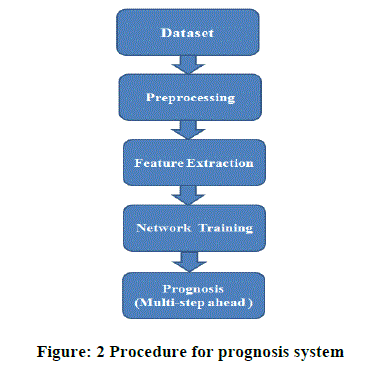 |
6. 1 ARCHITECTURE OF NETWORK MODEL |
| NARX neural network: Nonlinear Autoregressive Neural Network with eXogenous inputs (NARX) is a twolayer feed forward network, with a sigmoid transfer function in the hidden layer and a linear transfer function in the output layer. It is based on the linear ARX model, which is commonly used in time-series modeling. |
 |
| There are many applications for the NARX network. It can be used as a predictor, to predict the next value of the input signal. It can also be used for nonlinear filtering, in which the target output is a noise-free version of the input signal. |
6.2 FEATURE SELECTION |
| In this work, Bearing 1_1 acceleration (horizontal) and temperature data is used. The data is collected for a duration of 7h47m00s that is till failure happens. 20g is taken as a threshold value for RUL consideration. Peak value is considered as a CBM feature in this work. Peak value is considered because of its uniform ascending trend. |
| For Vibration Analysis 461 time steps are used as input to the neural network. Each time step corresponds to one minute. The target for the network is taken as the peak value (max g). |
| In case of temperature 466 time steps is taken as input and temperature as output. The vibration and temperature data are preprocessed before analysis. |
6.3 TRAINING |
| From Fig.4(vibration data) , it is observed that up to 350 time steps, there is gradual increase in degradation, however after 350, the peak values show steep hike with unevenness. The bearing is assumed to fail at 20g. The NARX network is trained for 350 time steps, and the network is expected to predict the next peak values from 350 onwards (next 100 time steps), as seen in Fig.5. |
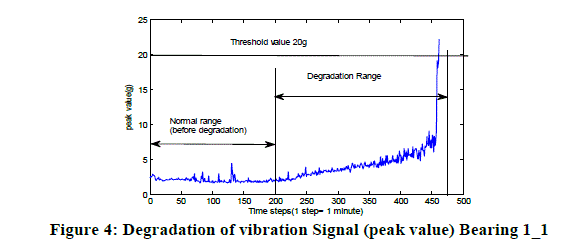 |
7. RESULT |
7.1 ACCELERATION |
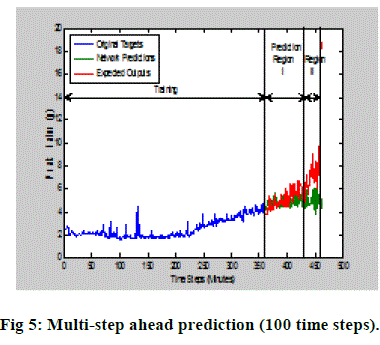 |
| As seen in Fig. 5, the error between the network predictions and expected outputs is minimal from 350-430, which is shown as prediction region I. However from 430 till end, due to chaotic nature of the signal, the error is found to be large. so multistep ahead prediction in region II is challenging and needs a better neural network and training. |
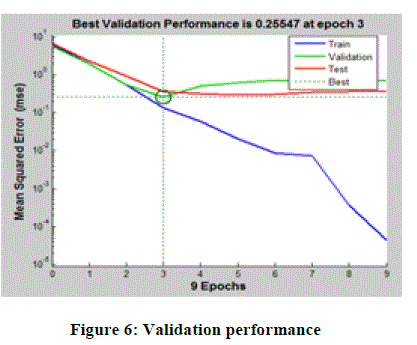 |
| The prediction error is less for 50 time steps as seen in Fig.7 |
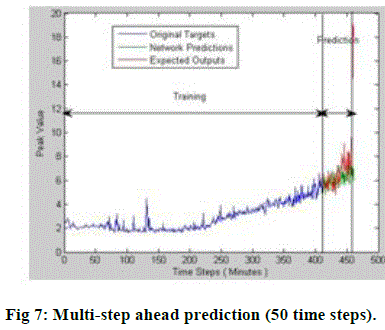 |
8. CONCLUSION |
| Machine condition prognosis is extremely essential in foretelling the degradation of operating conditions and trends of fault propagation before they reach the final failure threshold. In this paper, multi-step ahead prediction for bearing based on data-driven approach has been investigated. An attempt is made to design a neural network, which would give long term prediction values with minimum error. The Narx network trained in the prediction has produced satisfactory results. A better prognostic model will help in the estimation of accurate RUL. |
ACKNOWLEDGEMENT |
| The authors gratefully appreciate the help from FEMTO-ST Institute for providing the Bearing data. Comments and suggestions from any anonymous reviewers are very valuable in the improvement of the quality of this paper. |
References |
|